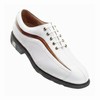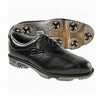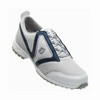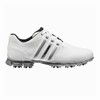Buying Advice: Golf Shoes
History
The debate over whether or not golf shoes will improve the game dates back 150 years. Back then, it was suggested that players wear sturdy shoes with small nails in them for better traction and more powerful swings, but these poorly fashioned shoes wreaked havoc on golfers and the courses on which they played. As technology has evolved, advances in golf shoes have made them lighter, more flexible, and much less dangerous. Though several tours have banned them from use and new technology arguably provides better performance-enhancing features, some purists still hold onto their metal-spiked golf shoes. No matter what type of golf shoes you wear, they are crucial to the success of your game. The right shoes can keep your feet secure and provide the support you need while you play, and they also keep you comfortable while you walk the course.
Types of Golf Shoes
When choosing which type of golf shoe is best, buyers have a lot of customization options starting with what kind of material they want. Traditional leather golf shoes are an investment as well as an overwhelmingly popular choice amongst players today. They cover your entire foot for protection and provide superior traction. The saddle shoe design is also a classic that serves the purpose of reinforcing the shoe with an extra strip of leather, which is breathable, durable, and waterproof. Today's shoes also come in cheaper synthetic fabrics like polyester (lighter than leather) and GORE-TEX® (heavier than leather) that are waterproof but also less durable. There are a lot of other choices on the market that build on the traditional idea of golf shoes. There are less expensive golf sandals for hot days and golf boots with higher tops that give you better protection from the elements but restrict movement and can cost a lot more.
Golf shoe spikes also come in a variety of styles and materials. Generally, spikes come in two types: metal and plastic. Metal spikes are becoming less common but are still used by many pros. They are longer and sharper for increased traction but are less comfortable and damage the greens quite severely, which is why some courses choose to ban them. Plastic spikes come in a variety of shapes and sizes and have become more common with players because they are much lighter, are more comfortable, and don't damage the course nearly as much as their metal counterparts. They are wider and spread the wearer's weight more evenly and arguably provide the same amount of traction as metal spikes, with the added benefit of easy change out. The only drawback to plastic spikes is that they break down much more quickly.
What to Know Before You Buy
Comfort
For players that are on their feet all day, comfort is of utmost importance. Next to bad weather, nothing ruins a game faster than sore feet and blisters. To find the most comfortable shoes, look for a pair that is lightweight and flexible but sturdy enough to offer adequate support. Make sure you try on any golf shoes you are seriously considering buying. If they don't feel comfortable enough on their own, try padded inserts. Good shoes will also be waterproof to keep your feet dry and comfortable during play.
Fit
Also important to the comfort of your shoes is the right fit. Measure both your feet and choose a size that fits the largest measurement. When you try on your shoes, make sure you wear the socks you want to wear when you play. Move around to ensure that your shoes bend and flex with the natural curves of your feet, but keep in mind that the middle portion of the shoe is designed for a tighter, more supportive fit while the other parts of the shoe may stretch over time. Also, see that the shoes fit but aren't tight. There should be some wiggle room for your toes at the end of each shoe. Though most golf shoes are designed for adult men, women and kids have differently proportioned feet and should look for shoes that are designed accordingly.
Style
Make sure the style of your shoes fits your personality and makes you feel the most comfortable. Shoes can be traditional, athletic, or trendy to suit how you like to play the game. Customizing your golf shoes is another expensive option, but it guarantees you'll get exactly what you want. These days, buyers can customize everything from the color of their shoes and laces to the spikes and exact shape of the shoe taken from personalized foot molds. You can even have your own name or logo branded onto your shoes. Just make sure to consider what materials and style of shoe will be best for how you need them to perform.
Cost
Golf shoes can range from a couple of bucks to a couple hundred to a couple thousand. They can be made from cheaper synthetic fabrics or the finest leathers, and everything in between. Leather shoes come in a variety of grades and get more expensive as the grade goes up. They will also be waterproof where synthetic shoes may only be water-resistant. Expensive shoes will be more comfortable, last longer, and improve your game the most. When deciding how much to spend on a pair of golf shoes, consider how often you will be playing in them. Serious players will need to invest more while casual players can probably afford to skimp a little. Keep in mind that some shoes may come with a warranty that, combined with good home care, will help you get your money's worth.
Conclusion
As with most purchases, it is important to consider what you will be using the product for when deciding exactly what you need and how much to spend. Maybe you always walk the entire course and will play all 18 holes come rain or shine, so you know you need a nicer pair of traditional leather golf shoes that are comfortable and protect your feet even though they may cost a bit more. Perhaps you are a more casual golfer that enjoys riding around in a cart and only plays once or twice a year for fun if the weather is nice, so you need less expensive golf shoes or even sandals. Keep in mind that, with golf shoes, you get what you pay for. A good pair of golf shoes will be more expensive but will last longer the better you take care of them. Try to maintain the original shape of your shoes by not putting anything heavy on them that could cause them to get deformed. Shoe trees will also help them keep their shape and draw out extra moisture. Make sure you clear them of any mud, grass, sand, or other debris and let them dry completely. You can also have a locker room attendant clean them for you! Regularly replace worn inserts and spikes, only use your shoes on the golf course, and regularly condition leather shoes. If you follow these tips, you'll enjoy playing in your golf shoes for years to come.






